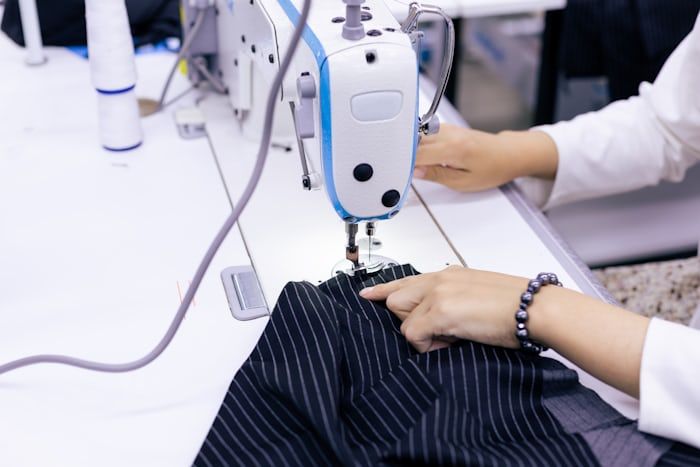The historic lag between a designer’s studio and a retailer’s stockroom once stretched over seasons: sketches became samples, samples became look-books, orders crawled through faxes and spreadsheets, and by the time finished garments reached the rail the mood they were meant to capture had moved on. Digital tools are now collapsing that gap. Generative-AI design engines, cloud product-lifecycle platforms, data-rich virtual showrooms, and predictive analytics are knitting creators and merchants into a single, near-real-time conversation. The result is faster launches, leaner inventories, and fewer missed trends—all built on a common layer of traceable data.

1. Digital product creation puts ideas on buyers’ screens in hours
Generative models can now turn a text prompt into a photorealistic garment complete with fabric drape and stitching detail. The best inventory management system also recently launched their AI fashion designer that transforms the image straight into a tech-pack inside the same ERP/PLM environment, letting brands preview dozens of colourways without cutting a single swatch. Early pilots report weeks shaved off the sketch-to-sample cycle and budgets redirected from physical mock-ups to consumer testing.
2. Cloud PLM turns hand-offs into a shared workspace
Once a concept exists as a 3D asset, cloud product-lifecycle-management suites keep every stakeholder—pattern makers, factories, merchandisers, and retailers—working on the same source file. Costings, bills of materials, and compliance certificates update the moment a sleeve width or fabric weight changes. Instead of volleying PDF attachments, a buyer can adjust order quantities while the designer is still refining the silhouette, and the revised margins appear immediately in the finance dashboard. That immediacy cuts the errors and duplication that once forced safety stock and markdowns.
3. Virtual showrooms bring wholesale into the streaming age
With digital samples in hand, brands no longer wait for traditional market weeks. Immersive 3D showrooms launch collections the moment virtual prototypes are approved. Retailers browse a web link, spin garments on screen, and place commitments against live production slots tied to factory capacity. Because the catalogue is pixel-based, labels can test a print with several buyers, gauge interest, and green-light only the styles that earn real orders, dramatically reducing the dead stock that drives markdown culture.
4. Predictive analytics align supply with social velocity
Artificial-intelligence forecasting engines ingest social-media sentiment, weather shifts, and real-time sell-through to predict demand at colour-size level. According to McKinsey’s State of Fashion Technology report, companies that embed such end-to-end digital processes—from AI design to data-driven forecasting—can cut time to market by up to fifty per cent, lift full-price sell-through eight per cent, and lower manufacturing costs twenty per cent.mckinsey.com Those projections are already playing out as brands trigger small replenishment runs the moment a TikTok trend spikes rather than guessing six months ahead.
5. Trusted data standards close the last mile of collaboration
Speed counts for little if retailers doubt the numbers behind a garment. Blockchain-secured product passports and IoT-enabled factories now let buyers verify fibre provenance, carbon footprint, and labour audits with a barcode scan. Shared confidence in the underlying data encourages retailers to commit earlier and gives regulators an auditable trail. Smaller labels, once locked out of global chains for lack of proof, can compete on equal footing if their digital passport meets the same standard as a heritage house.
6. Upskilling teams ensures technology delivers value
Software alone cannot mend the creator–retailer gap; people must adapt. Designers used to sketchpads need fluency in 3D interfaces, merchandisers steeped in Excel must read real-time dashboards, and buyers have to trust photorealistic renders over showroom samples. Training programs that pair technical skills with new performance metrics—speed to decision, sample-to-sell-through ratio—embed a culture where rapid iteration feels safe rather than risky. Companies that invest early in this human layer see adoption accelerate and the technology’s promises translate into profit.
Conclusion
Technology is turning fashion’s linear relay race into a live group chat where designers, makers, and merchants think out loud together. Sketches morph into sellable assets within hours; orders flow upstream before a single bolt of fabric is unrolled; demand signals loop back to trigger the next wave of ideas. Bridging the creator–retailer gap does not replace craftsmanship or curation—rather, it frees both to flourish by stripping out the latency that once dulled inspiration on its journey to the shop floor. In the new cadence of fashion, the distance between imagination and availability is measured not in months but in clicks, and everyone from the cutting table to the cash desk stands to gain.
Post Comment
Be the first to post comment!





